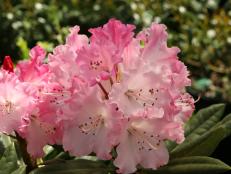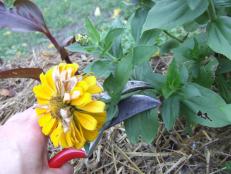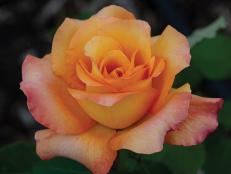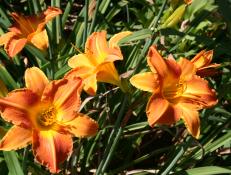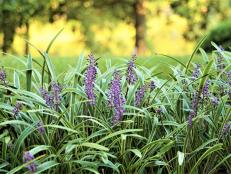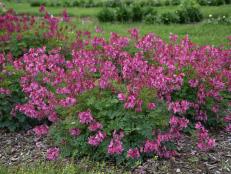How to Grow Desert Rose
Find out how to grow and care for desert rose plants from the garden experts at HGTV.

Desert rose plants are easy-to-grow tropical succulents with swollen trunks. They're sometimes mistaken for bonsai trees.

Desert rose plants are native to hot, sunny East Africa and Arabia. These flowering plants can be grown indoors in containers or outside in the garden in USDA zones 10 to 11, where the winters are warm. Experts think there may be only one true species, but hybrids are available with trumpet-shaped flowers in white, bicolors and stripes. You can also find plants with orange, rose, yellow, pink and red single or double blooms, and some have variegated foliage.
What Is a Desert Rose Plant, Anyway?
Desert roses, or Adeniums, are tropical succulents that thrive in well-drained soil and in at least six hours of full sun each day. When grown as houseplants, these low-maintenance beauties need bright light. If you grow them outside, give them some protection from the sun during the hottest part of the day, so it won't scorch their leaves. They can tolerate temperatures up to 90 degrees F, but can't survive below 40 degrees F.
You might mistake desert roses for bonsai plants, because they're short and have a caudex, or swollen trunk. That's where they store excess moisture. When you buy a desert rose, choose one with a plump caudex, which indicates it's been well-watered and isn't suffering from drought.
All parts of the desert rose plant contain a poisonous sap, so don't allow children or pets to come in contact with it. If you grow it outside, don't let pets in the area where it's been growing. Wear gloves to protect your hands when working with this plant, and if sap gets on your hands or body, immediately wash it off with soap and water.

Costa Farms
Desert roses typically break dormancy and produce a few flowers in late winter. Leaves and more flowers appear into the summer and fall.
How to Grow a Desert Rose
Desert roses don't need much moisture, so grow them in cactus potting soil that drains quickly. During the spring and summer, water them regularly and let the soil dry out between waterings. In the fall, start cutting back on watering, and water just enough in the winter, while your plant is dormant, to keep its leaves from dropping.
Bring an outdoor plant in when the temperature drops to 50 degrees F. It may lose its leaves, but the leaves usually stay on if the plant is in a room where the temperature stays at least 60 degrees F.
Feed the plants in spring and summer with a balanced, slow-release fertilizer, or apply a liquid fertilizer as directed on the product label. Because these plants grow slowly, pruning isn't necessary. They can be kept in small pots to enjoy as bonsai-like specimens. If you want to shape your plant, prune in early summer so the cuts have time to heal.
How to Propagate Desert Rose
Most desert rose plants are grown from seed. If your plant forms seed pods, plant the seeds as soon as the pods open. Let them germinate and grow for about a month before transplanting the seedlings into a larger container. Some gardeners start new desert rose plants from branch cuttings, but plants grown from cuttings seldom form the plump trunks that the plants are known for.
How to Control Desert Rose Pests
Scale, spider mites and mealybugs sometimes attack desert roses. Armored scales are tan or brown insects with shell-like coatings that suck sap from plants. They usually hide underneath leaves or where plant leaves attach to stems and can eventually cause the plant's foliage to turn yellow and droop. The plant can weaken and even die.
Soft scale insects can be various colors, and some have waxy coatings. Like their armored relatives, they damage or kill plants by sucking their juices. Soft scales produce a clear, sticky substance on leaves called honeydew, which often draws ants. Honeydew can also encourage the growth of sooty mold, a harmful fungus.
To control a small infestation of either kind of scale, pick the insects off your plant or kill them by touching them with a cotton swab dipped in rubbing alcohol. If the infestation is heavy, try insecticidal soap. To make your own insecticidal soap, mix 1 1/2 teaspoons of mild dish detergent with a quart of water and spray the mixture on the leaves. Don't use the soap mixture or alcohol on a hot day or when your plant is in the sun, which could burn the foliage. It's a good idea to try the alcohol or homemade insecticide on just a few leaves first, to make sure the treatment won't harm the plant.
If you prefer, spray your desert rose with neem oil or a horticultural oil made to control scale and follow the directions on the label. In severe cases, you may have to discard the plant and start over with a new, healthy one.
Mealybugs are also desert rose pests. They usually look like tiny, white, cottony spots on foliage and stems. Like scale, they can create sticky honeydew and harm your plant by sucking its sap. If you spot mealybugs, quarantine your desert rose away from anything else you're growing and wash the plant with a mixture of one part alcohol to three parts water and a few drops of mild dish soap. Repeat in a few days if you still see mealybugs. As an alternative, banish the mealybugs with neem oil or a pesticide, following the label directions.
Spider mites may show up as tiny brown or yellow spots or spider-like webs on plant leaves. Eliminate a light infestation by spraying your plant with a stream of water from your kitchen sprayer or a garden hose. If they return, use neem oil, a dormant oil, horticultural oil or a miticide. Do not use a pesticide made for regular spiders.
How to Control Desert Rose Diseases
Desert roses usually grow slowly and top out around four feet tall. After decades, old plants could grow to six feet or more.
Desert roses are sometimes plagued by stem rot, which starts on the tips of the plants and makes its way down the stems. Leaf rot is another common problem that can occur when the leaves stay wet.
Leaf rot. To control leaf rot, remove the diseased leaves and let the plant dry out before you water again. Avoid getting water on the foliage and keep the plant in a location where it can dry out quickly. If you're watering outdoor plants, water early in the day, so the leaves can dry before nightfall.
Stem rot. Stem rot shows up as black, yellow or brown wet or dry patches on desert rose stems; it's caused by a fungus. Sometimes the plant will form an abscission zone, or an area of new growth around the infection. After it appears, the rotted stem can be snapped off. If the zone doesn't form, cut off the discolored part of the stem and look down into the part of the stem that remains on the plant. if you can see still discolored tissue, cut again until you see healthy tissue.
Caudex rot. This rot occurs in the swollen trunk and main stems of desert roses. It causes the leaves to turn yellow, but they don't always fall off. Before you discard your plant, watch to see if it recovers on its own. Large desert roses can sometimes survive this kind of rot.
How to Use Desert Rose in the Garden
Companion Plants for Desert Roses
Showy desert roses are standouts in a garden when planted with other succulents and cacti that have the same basic needs for light and water. While their blooms often attract butterflies, deer and rabbits typically leave desert roses alone.
Popular Varieties
- Picotee desert rose - White flowers with red or pink edges
- Purple desert rose - Blooms in shades of purple that lighten to lavender
- ‘Good Night’ - A near-black desert rose, the result of hybridizing
- ‘Golden Carrot’ - A new Adenium that may be hard to find. It bears double, yellow-orange flowers accented with red.
- ‘Yellow Fragrance’ - Double yellow blooms have vivid red stripes and a light scent.










